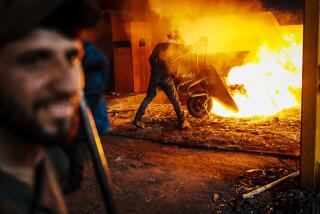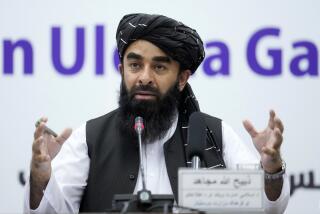Afghan Allies Yesterday, Foes Today
- Share via
KABUL, Afghanistan — The terrified governor cowered in his mansion as the armed men rampaged outside.
A team of eight British soldiers fought its way in. The soldiers formed a circle around the governor, Enayatullah Enayat, and pushed their way to safety.
After the attack on Enayat by men loyal to warlord Abdul Rashid Dostum last week, President Hamid Karzai ordered the deployment of 750 soldiers from the fledgling Afghan National Army to restore peace in Faryab, a remote northern province.
But the governor, now hiding somewhere near the Turkmenistan border, has refused to obey Karzai’s orders to go back to Faryab. He is frightened of Dostum.
The events in Meymaneh, the capital of Faryab, have provided ammunition for an increasing number of people who are worried that the U.S.-declared war against terrorism is destabilizing Afghanistan.
On Saturday, Deputy Defense Minister Rahim Wardak called on the U.S. government to deal with warlords such as Dostum, who had received weapons and funding from America to help in the fight against the Al Qaeda terrorist network and the Taliban.
“A lot of these warlords, before Sept. 11, did not exist or had no power,” he said. “They were created by the United States after 9/11, and it is their responsibility to deal with them.”
Dostum is refusing to relinquish his power and disarm his private army as the country tries to establish the rule of law. Wardak said Saturday that the central government in Kabul was determined to rid the country of warlords ahead of elections later this year.
“He, Dostum, will get tamed,” Wardak said. “All the shrews get tamed eventually.”
The 80-member British provincial reconstruction team that orchestrated Enayat’s rescue is based in the nearby city of Mazar-i-Sharif and frequently brokers peace talks between rival military factions.
The Faryab unrest was the second time in a month that a warlord had provoked a confrontation with the central government.
In the western province of Herat, warlord Ismail Khan fought a Kabul-backed military commander in March, leaving 16 people dead.
Andrew Wilder of the Afghanistan Research and Evaluation Unit, a think tank based in Kabul, the capital, said there was no long-term strategy to rebuild the country as the war on terrorism continued.
“We have been dealing with [a] narrowly defined war on terror, and unless there is a willingness to broaden that definition to take a war against those who are terrorizing Afghans and not just terrorizing the West, I think we are going to fail in Afghanistan.”
The United Nations is supervising the disarmament of about 100,000 militiamen, but the process has been slow.
It has not helped that the defense minister, Mohammed Qassim Fahim, is a powerful commander with U.S. backing who is reluctant to disarm his men.
At the same time, the U.S.-led coalition, under increasing pressure to capture Al Qaeda leader Osama bin Laden, has proposed rearming some militias. Under the proposal, up to 6,000 men would be trained to act as “national guards” and fight in the southern and eastern provinces where Taliban insurgents are regrouping and attacking coalition troops.
“It will take us back to the fall of 2001 with a second infusion of cash and arms to commanders,” said Vikram Parekh, senior analyst with the International Crisis Group, a research organization. “There is just no synergy between the coalition strategy and the political process.”
More to Read
Sign up for Essential California
The most important California stories and recommendations in your inbox every morning.
You may occasionally receive promotional content from the Los Angeles Times.













